Ideal solutions for planning slopes
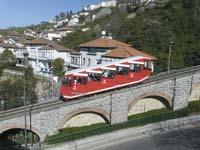
XIX. In the first half of the 20th century, systems for the rise and fall of large railway-based slopes began to be built around the world. At that time, the train was the most efficient means of transport. As the friction between the iron wheels and the railways is low, "a certain freight train can carry a load that would carry thirty trucks, consuming only the fuel that ten trucks would consume," says Juanjo Olaizola, director of the Azpeitia Railway Museum.
However, conventional trains have a great disability: they are not able to climb slopes. "Climbing a 2% slope for a train is mountaineering," explains Olaizola. As the friction between the two surfaces in contact is low, they begin to slide down a certain slope. And precisely because the goal was to climb steep slopes, ways to overcome this obstacle were invented.
Up and down on the zipper
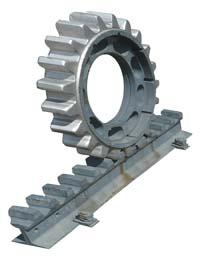
If, in addition to the two conventional lanes, another one is placed on the track, the toothed one, and a gear wheel is placed that will connect the train with it, it is possible to avoid, in large measure, the sliding, both up and down, when it is necessary to moderate the speed.
This is the train that goes up to Mount Larrun, the Tiki Train of Larrun. It is the only zipper train that currently works in Euskal Herria. It was inaugurated in 1924 and has since taken on the same aspect. According to the train website, when they had to restore the train, they have renovated all the components of the train based on the original plans, from the chassis of the cars to all the wooden parts. The restorations used the same types of wood as at the time of construction.
From the beginning it has been the train of Larrun to take tourists, since from the top there are impressive views: a clear day you can see the seven provinces of Euskal Herria. Apparently, Montijo's Eugenia climbed to Larrune and his fascination aroused the idea of the train. In fact, in the chronology of the Larrun train it can be observed that the Eugenio de Montijo is the first incident to which it refers.
As in Larruna, other zip trains that exist in the world were built to attract tourists. This is, for example, the first zipper train to be built in the world, inaugurated in 1869 on Mount Washington in the United States. In Europe, the oldest zipper train is located in the Swiss Alps: It climbs Mount Rigi and works since 1871.
One cable and two wagons: funicular
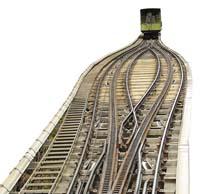
At the base, the funicular is a system with a wagon at each end: one of them is at the top of the slope that you want to climb and the other at the bottom. The goal is to use the upper weight to make the counterweight and climb the lower down. Passing the wire that connects both by a pulley is easy to achieve this movement.
To start the movement it is necessary that the upper wagon has greater weight than the lower. However, not only with the passengers, but they launched on other ways to move the cars. Sometimes a reservoir filled with water that had the upper wagon until its weight was enough to overcome the one below, to collapse by itself. This is how the funicular{ Jesus of Braga works today, in Portugal.
Instead of playing with weight, they managed to move the wagons on other occasions by moving the pulleys directly. Sometimes they used animals (blood engines were called systems moving with animals) and sometimes motors, both steam and electric.
In Euskal Herria there are currently three funicular: Igeldo, Donostia, Artxanda, Bilbao and Larreineta, Trapagaran. The first two were created for recreational uses. In Donostia-San Sebastián and Bilbao, in the upper part of the city, a recreation area was set up so that people would climb there to enjoy the views of the city and breathe cleaner air. In both, restaurants, casinos and, in San Sebastian, the amusement park of Igeldo were installed.
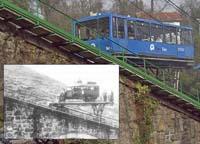
Larreineta's is special. "It was not created to attract tourists, but to provide a public service," says Olaizola. In fact, the municipality of Trapagarán has two cores, among which is a slope of 342 meters. "Between 5,000 and 6,000 people lived in Goikoa in the Larreineta area. In the first quarter of the century, working in the mines of the area, they saw reds to go down to the valley." At that time, of course, there was no car and the distance between the two neighborhoods where the mules were used or made was very dangerous, since there were big slopes. For this reason the Council created the funicular in 1926.
Therefore, it was not only travelers who had to be moved from one neighborhood to another, but also food, coal and other materials to meet the needs of the population. And those needs were also met through the funicular. That is why Larreineta and the other two have a different aspect: the other two have a staircase shape, while in Larreineta the passenger car is on a horizontal platform. In the upper and lower stations you can remove the passenger car and climb any other vehicle, such as a truck, car or any other.
Traction in case of continuous cable
If in the world there are cities with a lot of slope, that city is San Francisco (California): 50 hills in the urban area. On these slopes, with chariots of horses, they ascended and descended the XIX. In the 20th century, accidents occurred several times. In fact, in view of one of those accidents it occurred to engineer Andrew Hallidie to design such a famous cable tram in the city, known in English as cable-car. It was inaugurated in 1873.
"It's amazing to see what slopes the San Francisco trams are climbing," says Olaizola. In this case, the cable that moves the wagons is continuous, without cuts and in continuous movement. This cable circuit crosses the city, but runs underground between the two tram lanes. The tram has a central flange through which it connects to the cable when it wants to move. To stop it, simply unhook the cable and operate the brake.
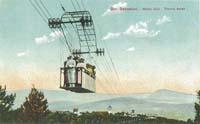
In addition, the San Francisco tram had the advantage of not filling the streets with smoke. In this way, they managed to take advantage of the advantage offered by the railways and, at the same time, avoid the discomfort caused by the trains. In fact, "at that time the locomotives were steam and emitted a huge smoke," explains Olaizola.
However, San Francisco trams do not have any engine. The trams' cables generate the energy needed to move in a power station and the smoke that, otherwise the power station emitted, would have been expelled throughout the city. Thus, it did not bother anyone, since at that time it was on the outskirts of the city
The first cable tram was the one in San Francisco, the only one currently operating among these systems. In Euskal Herria there has never been a cable tram. However, Olaizola stressed that there is a certain relationship between this type of trams and, in particular, the Swiss mountain located on Mount Igeldo: "The Swiss mountain is also a cable tram." In fact, it is attached to a cable to the highest point of the route. Then it is released from the cable and the rest is done with gravity and inertia force.
Nostalgia, traction force
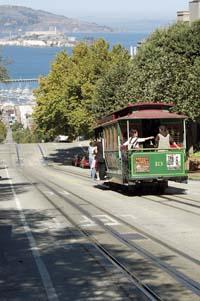
Despite their seniority, many of these special trains still operate today, and many remain the same or similar mechanism as before. "There is no need to change the mechanisms," says Olaizola. When they were created, they took security measures into account, as the reason why these systems were created was the rise of large slopes. "They took excessive security measures," he added.
In addition, its old appearance brings added value to trains today, since they are mainly used for tourism. Many are not profitable but, however, have remained. Somehow, people like and look at them with nostalgia, from time to time make a small leap into the past.
But they are not mere witnesses of ingenious solutions of the past. Think of the system by which today we climb, when we do not climb on foot, to the places that are on high slopes or at high altitude: they are escalators, inclined elevators ready to join two neighborhoods of different heights in several cities, lifts common at home, ski lifts, telecavines, cable cars, teleaulquias, etc. Don't everyone look like any of the systems mentioned? According to Olaizola, "they are modern systems derived from those technologies that they invented in their day."
Buletina
Bidali zure helbide elektronikoa eta jaso asteroko buletina zure sarrera-ontzian











